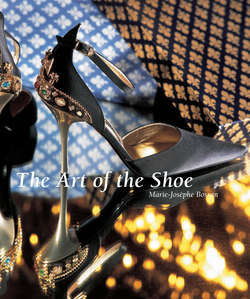Читать книгу The Art of the Shoe - Marie-Josèphe Bossan - Страница 16
На сайте Литреса книга снята с продажи.
From Antiquity up to our days
The Legend of Saint Crispin and Saint Crispinian
ОглавлениеCrispin and Crispinian were two brothers from a patrician Roman family who converted to Christianity under the reign of Diocletian (245–313). Pope Caius (283–296) gave them the task of converting Gaul and in 285 AD they settled in Soissons to work as shoemakers and to preach the word of God. When the Roman general Maximianus Herculeus asked them to renounce their faith and to worship pagan idols, the brothers refused, which led to their frequent and cruel persecution. They were flagellated, pierced with awls, burned with boiling oil and molten lead, and finally thrown into the river Aisne with a millstone around their neck. Then a miracle occurred: the stone came loose and the shoemakers reached shore safe and sound, praising God. When Maximianus got the news, he had their heads cut off in 287.
Although their remains were left for vultures, the shoemakers’ bodies remained in tact; two old beggars gave the martyrs a proper burial. In 649, the Bishop of Soissons, named Ansérik, moved the two brothers’ remains into the crypt of his basicala, which later came to be called the Abbaye Saint-Crépin-le-Grand. When the shoemaker’s guild was established in the cathedral of Paris in 1379 by king Charles-le-Sage (1338–1380), the shoemakers chose Saint Crispin and Saint Crispinian as their patrons, whom they formally celebrate on October 25th. Many images of Saint Crispin and Saint Crispinian are still preserved in the chapels of parish churches where late medieval guilds paid tribute to their patron saints and dedicated altars.
31. Sign of shoemaker-bootmaker, “To Saint Crispin”. 1593. Carnavalet Museum, Paris.
32. Retable of the “Master at the Eyelets” (1500–1510): two scenes in the life of Saint Crispin and Saint Crispinian. Scweizerisches Landesmuseum, Zurich.
33. The Martyr of Saints Crispin and Crispinian, votive offering of 1594 by painter Vital Despigoux. Panel on wood. Clermont-Ferrand Cathedral, Puy-de-Dôme.
34. Carpaccio. Two Venetian Courtesans, 1500. Correr Museum, Venice.
